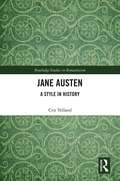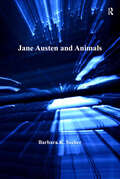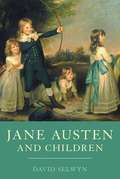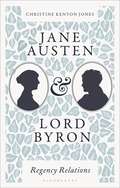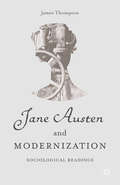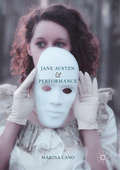- Table View
- List View
Jane Austen
by Tony TannerTanner...demonstrates the value of close reading...he can see what has rarely been noticed.' Bruce Stovel, The International Fiction Review '...characteristically witty and effective...offers fascinating and occasionally brilliant readings of some of the finest novels in English.' Carolyn Wilkerson Bell, Magill's Literary Annual 1987
Jane Austen: A Life
by Claire TomalinJane Austen is the definitive biography of one of Britain's best-loved novelists, from the acclaimed author of Samuel Pepys: The Unequalled Self, Charles Dickens: A Life and The Invisible Woman'As near perfect a life of Austen as we are likely to get: intelligent, feeling, suggestive' Carmen Callil, Daily Telegraph'Tomalin has written a biography that reflects Austen's own exacting standards, a book that radiates intelligence, wit and insight' Michiko Kakutani, The New York Times'Of all the Austen biographies, this is the best ... leaves the reader with a much deeper appreciation of the circumstances and motivation behind the creation of those six perfect novels' Harpers & Queen'I cannot think that a better life of Jane Austen then Claire Tomalin's will be written for many years.' Philip Hensher, Mail on Sunday'A perfect biography: detailed, witty, warm. Tomalin involves us so deeply that Austen's final illness and death come almost as a personal tragedy to the reader' Dirk Bogarde, Daily Telegraph, Books of the Year
Jane Austen: A Style in History (Routledge Studies in Romanticism)
by Cris YellandFrom 1809 until just before her death, Jane Austen lived in a small, all-female household at Chawton, where reading aloud was the evening's entertainment and a crucial factor in the way Austen formed and modified her writing. This book looks in detail at Jane Austen's style. It discusses her characteristic abstract vocabulary, her adaptations of Johnsonian syntax and how she came to make her most important contribution to the technique of fiction, free indirect discourse. The book draws extensively on historical sources, especially the work of writers like Johnson, Hugh Blair and Thomas Sheridan, and analyses how Austen negotiated her path between the fundamentally masculine concerns of eighteenth-century prescriptivists and her own situation of a female writer reading her work aloud to a female audience.
Jane Austen: A Style in History (Routledge Studies in Romanticism)
by Cris YellandFrom 1809 until just before her death, Jane Austen lived in a small, all-female household at Chawton, where reading aloud was the evening's entertainment and a crucial factor in the way Austen formed and modified her writing. This book looks in detail at Jane Austen's style. It discusses her characteristic abstract vocabulary, her adaptations of Johnsonian syntax and how she came to make her most important contribution to the technique of fiction, free indirect discourse. The book draws extensively on historical sources, especially the work of writers like Johnson, Hugh Blair and Thomas Sheridan, and analyses how Austen negotiated her path between the fundamentally masculine concerns of eighteenth-century prescriptivists and her own situation of a female writer reading her work aloud to a female audience.
Jane Austen among Women
by Deborah KaplanIn an age when genteel women wrote little more than personal letters, how did Jane Austen manage to become a novelist? Was she an isolated genius who rose to fame through sheer talent? Did she draw strength from the support of her family or from women writers who went before her? In Jane Austen among Women, Deborah Kaplan argues that these explanations are either misleading or insufficient. Austen, Kaplan contends, participated actively in a women's culture that promoted female authority and achievement—a culture that not only helped her become a novelist but also influenced her fiction.
Jane Austen among Women
by Deborah KaplanOriginally published in 1992. In an age when genteel women wrote little more than personal letters, how did Jane Austen manage to become a novelist? Was she an isolated genius who rose to fame through sheer talent? Did she draw strength from the support of her family or from women writers who went before her? In Jane Austen among Women, Deborah Kaplan argues that these explanations are either misleading or insufficient. Austen, Kaplan contends, participated actively in a women's culture that promoted female authority and achievement—a culture that not only helped her become a novelist but also influenced her fiction.
Jane Austen among Women
by Deborah KaplanOriginally published in 1992. In an age when genteel women wrote little more than personal letters, how did Jane Austen manage to become a novelist? Was she an isolated genius who rose to fame through sheer talent? Did she draw strength from the support of her family or from women writers who went before her? In Jane Austen among Women, Deborah Kaplan argues that these explanations are either misleading or insufficient. Austen, Kaplan contends, participated actively in a women's culture that promoted female authority and achievement—a culture that not only helped her become a novelist but also influenced her fiction.
Jane Austen and Animals
by Barbara K. SeeberThe first full-length study of animals in Jane Austen, Barbara K. Seeber’s book situates the author’s work within the serious debates about human-animal relations that began in the eighteenth century and continued into Austen’s lifetime. Seeber shows that Austen’s writings consistently align the objectification of nature with that of women and that Austen associates the hunting, shooting, racing, and consuming of animals with the domination of women. Austen’s complicated depictions of the use and abuse of nature also challenge postcolonial readings that interpret, for example, Fanny Price’s rejoicing in nature as a celebration of England’s imperial power. In Austen, hunting and the owning of animals are markers of station and a prerogative of power over others, while her representation of the hierarchy of food, where meat occupies top position, is identified with a human-nature dualism that objectifies not only nature, but also the women who are expected to serve food to men. In placing Austen’s texts in the context of animal-rights arguments that arose in the late eighteenth and early nineteenth centuries, Seeber expands our understanding of Austen’s participation in significant societal concerns and makes an important contribution to animal, gender, food, and empire studies in the nineteenth century.
Jane Austen and Animals
by Barbara K. SeeberThe first full-length study of animals in Jane Austen, Barbara K. Seeber’s book situates the author’s work within the serious debates about human-animal relations that began in the eighteenth century and continued into Austen’s lifetime. Seeber shows that Austen’s writings consistently align the objectification of nature with that of women and that Austen associates the hunting, shooting, racing, and consuming of animals with the domination of women. Austen’s complicated depictions of the use and abuse of nature also challenge postcolonial readings that interpret, for example, Fanny Price’s rejoicing in nature as a celebration of England’s imperial power. In Austen, hunting and the owning of animals are markers of station and a prerogative of power over others, while her representation of the hierarchy of food, where meat occupies top position, is identified with a human-nature dualism that objectifies not only nature, but also the women who are expected to serve food to men. In placing Austen’s texts in the context of animal-rights arguments that arose in the late eighteenth and early nineteenth centuries, Seeber expands our understanding of Austen’s participation in significant societal concerns and makes an important contribution to animal, gender, food, and empire studies in the nineteenth century.
Jane Austen and Children
by David SelwynJane Austen is not usually associated with children - especially since she had none of her own. But there are in fact more children in her novels than one might at first think. She herself was from a sizeable family, with numerous nephews and nieces. She was, by all accounts, good with children and popular with them. It was therefore natural for her to include them in her novels, even if sometimes offstage. This book, by one of the world's leading authorities on Austen, looks at both the real and the literary children in her life - children seen and unseen (and dead); children as models of behaviour, good and bad; as objects of affection, amusement, usefulness, pity, regret, jealousy, resentment; children in the way; children as excuses; children as heirs. In the process it casts fascinating light on a hitherto largely ignored aspect of her work and the age in which she lived.
Jane Austen and Children
by David SelwynJane Austen is not usually associated with children - especially since she had none of her own. But there are in fact more children in her novels than one might at first think. She herself was from a sizeable family, with numerous nephews and nieces. She was, by all accounts, good with children and popular with them. It was therefore natural for her to include them in her novels, even if sometimes offstage. This book, by one of the world's leading authorities on Austen, looks at both the real and the literary children in her life - children seen and unseen (and dead); children as models of behaviour, good and bad; as objects of affection, amusement, usefulness, pity, regret, jealousy, resentment; children in the way; children as excuses; children as heirs. In the process it casts fascinating light on a hitherto largely ignored aspect of her work and the age in which she lived.
Jane Austen and Critical Theory
by Michael KrampJane Austen and Critical Theory is a collection of new essays that addresses the absence of critical theory in Austen studies—an absence that has limited the reach of Austen criticism. The collection brings together innovative scholars who ask new and challenging questions about the efficacy of Austen’s work. This volume confronts mythical understandings of Austen as "Dear Aunt Jane," the early twentieth-century legacy of Austen as a cultural salve, and the persistent habit of reading her works for advice or instruction. The authors pursue a diversity of methods, encourage us to build new kinds of relationships to Austen and her writings, and demonstrate how these relationships might generate new ideas and possibilities—ideas and possibilities that promise to expand the ways in which we deploy Austen. The book specifically reminds us of the vital importance of Austen and her fiction for central concerns of the humanities, including the place of the individual within civil society, the potential for new identities and communities, the urgency to address racial and sexual oppression, and the need to imagine more just futures.
Jane Austen and Critical Theory
by Michael KrampJane Austen and Critical Theory is a collection of new essays that addresses the absence of critical theory in Austen studies—an absence that has limited the reach of Austen criticism. The collection brings together innovative scholars who ask new and challenging questions about the efficacy of Austen’s work. This volume confronts mythical understandings of Austen as "Dear Aunt Jane," the early twentieth-century legacy of Austen as a cultural salve, and the persistent habit of reading her works for advice or instruction. The authors pursue a diversity of methods, encourage us to build new kinds of relationships to Austen and her writings, and demonstrate how these relationships might generate new ideas and possibilities—ideas and possibilities that promise to expand the ways in which we deploy Austen. The book specifically reminds us of the vital importance of Austen and her fiction for central concerns of the humanities, including the place of the individual within civil society, the potential for new identities and communities, the urgency to address racial and sexual oppression, and the need to imagine more just futures.
Jane Austen and Her Art
by Mary LascellesFirst published in 1939, Jane Austen and Her Art is a landmark in Jane Austen criticism. This was the first book to provide a full-scale account of the writer based upon thoroughhistorical and biographical scholarship; and on the critical front, Mary Lascelles broke new ground in applying the ideas of Henry James on the 'art' of the novel.In the years since the first publication of Jane Austen and Her Art, there has come an overwhelming body of critical writing about Jane Austen. But this classic study maintains its unique position, unchallenged and unimproved upon in its analysis of Jane Austen's style and narrative art and the experience of life and literature which formed the novels. A book for all students of Jane Austen, it is equally, as WinifredHusbands wrote in the Modern Language Review, a book for 'all lovers of Jane Austen'.
Jane Austen and Literary Theory (Routledge Studies in Nineteenth Century Literature)
by Shawn NormandinJane Austen was one of the most adventurous thinkers of the late eighteenth and early nineteenth centuries, but one would probably never guess that by reading her critics. Perhaps no canonical author in English literature has proven, until now, more resistant to theory. Tracing the political motives for this resistance, Jane Austen and Literary Theory proceeds to counteract it. The book’s detailed interpretations guide readers through some of the important intellectual achievements of Austen’s career—from the stunning teenage parodies "Evelyn" and "The History of England" to her most accomplished novels, Pride and Prejudice, Mansfield Park, and Emma. While criticism has largely been content to describe the various ways Austen was a product of her time, Jane Austen and Literary Theory reveals how she anticipated the ideas of formidable literary thinkers of the twentieth century, especially Jacques Derrida and Paul de Man. Gift and exchange, speech and writing, symbol and allegory, stable irony and Romantic irony—these are just a few of the binary oppositions her dazzling texts deconstruct. Although her novels are major achievements of nineteenth-century realism, critics have hitherto underestimated their rhetorical cunning and their fascination with the materiality of language. Doing justice to Austen’s language requires critical methods as ruthless as her irony, and Jane Austen and Literary Theory supplies these methods. This book will enable both her devotees and her detractors to appreciate her genius in unusual ways.
Jane Austen and Literary Theory (Routledge Studies in Nineteenth Century Literature)
by Shawn NormandinJane Austen was one of the most adventurous thinkers of the late eighteenth and early nineteenth centuries, but one would probably never guess that by reading her critics. Perhaps no canonical author in English literature has proven, until now, more resistant to theory. Tracing the political motives for this resistance, Jane Austen and Literary Theory proceeds to counteract it. The book’s detailed interpretations guide readers through some of the important intellectual achievements of Austen’s career—from the stunning teenage parodies "Evelyn" and "The History of England" to her most accomplished novels, Pride and Prejudice, Mansfield Park, and Emma. While criticism has largely been content to describe the various ways Austen was a product of her time, Jane Austen and Literary Theory reveals how she anticipated the ideas of formidable literary thinkers of the twentieth century, especially Jacques Derrida and Paul de Man. Gift and exchange, speech and writing, symbol and allegory, stable irony and Romantic irony—these are just a few of the binary oppositions her dazzling texts deconstruct. Although her novels are major achievements of nineteenth-century realism, critics have hitherto underestimated their rhetorical cunning and their fascination with the materiality of language. Doing justice to Austen’s language requires critical methods as ruthless as her irony, and Jane Austen and Literary Theory supplies these methods. This book will enable both her devotees and her detractors to appreciate her genius in unusual ways.
Jane Austen and Lord Byron: Regency Relations
by Christine Kenyon JonesJane Austen and Lord Byron are often presented as opposites, but here they are together at last. In Regency England he was the first celebrity author while she was a parson's daughter writing anonymously. This book explores how their lives, interests, work and sense of humour often brought them within touching distance, and sets them side by side in the world of the Regency and Romantic period. Using some little-known sources and new research, it illustrates how they were distantly related by marriage; how they knew about each other even though they probably never met; the acquaintances they had in common and how their literary work often came close in subject-matter, approach, technique and tone.Engagingly written and beautifully illustrated, this book will inform and delight scholars and Austen and Byron fans alike, showing that these two great authors were closer than you might think, even in their own day.
Jane Austen and Lord Byron: Regency Relations
by Christine Kenyon JonesJane Austen and Lord Byron are often presented as opposites, but here they are together at last. In Regency England he was the first celebrity author while she was a parson's daughter writing anonymously. This book explores how their lives, interests, work and sense of humour often brought them within touching distance, and sets them side by side in the world of the Regency and Romantic period. Using some little-known sources and new research, it illustrates how they were distantly related by marriage; how they knew about each other even though they probably never met; the acquaintances they had in common and how their literary work often came close in subject-matter, approach, technique and tone.Engagingly written and beautifully illustrated, this book will inform and delight scholars and Austen and Byron fans alike, showing that these two great authors were closer than you might think, even in their own day.
Jane Austen and Modernization: Sociological Readings
by J. ThompsonJane Austen wrote when sociology was being established as the new discipline to understand social issues such as urbanization and industrialization. Drawing on landmark sociologists such as Durkheim and Bourdieu, this study argues that the novels of Austen were heavily influenced by these early developments in sociology.
Jane Austen and Narrative Authority
by T. WallaceIn Jane Austen and Narrative Authority, Tara Ghoshal Wallace argues that far from embodying ideological and technical serenity, Austen's novels articulate a range of anxieties about authorship and authority. The novels experiment in different ways with possible sources and the ultimate failures of authority, always returning to the compromised figure of the narrator. Wallace suggests that Austen's novelistic output can be read as a theory of interpretation, thematizing problems of narrative authority and readers' resistance.
Jane Austen and Performance
by Marina CanoThis is the first exploration of the performative and theatrical force of Austen’s work and its afterlife, from the nineteenth century to the present. It unearths new and little-known Austen materials: from suffragette novels and pageants to school and amateur theatricals, passing through mid-twentieth-century representations in Scotland and America. The book concludes with an examination of Austen fandom based on an online survey conducted by the author, which elicited over 300 responses from fans across the globe. Through the lens of performative theory, this volume explores how Austen, her work and its afterlives, have aided the formation of collective and personal identity; how they have helped bring people together across the generations; and how they have had key psychological, pedagogical and therapeutic functions for an ever growing audience. Ultimately, this book explains why Austen remains the most beloved author in English Literature.
Jane Austen and Performance
by Marina CanoThis is the first exploration of the performative and theatrical force of Austen’s work and its afterlife, from the nineteenth century to the present. It unearths new and little-known Austen materials: from suffragette novels and pageants to school and amateur theatricals, passing through mid-twentieth-century representations in Scotland and America. The book concludes with an examination of Austen fandom based on an online survey conducted by the author, which elicited over 300 responses from fans across the globe. Through the lens of performative theory, this volume explores how Austen, her work and its afterlives, have aided the formation of collective and personal identity; how they have helped bring people together across the generations; and how they have had key psychological, pedagogical and therapeutic functions for an ever growing audience. Ultimately, this book explains why Austen remains the most beloved author in English Literature.
Jane Austen and Reflective Selfhood: Rereading the Self
by Linda CharltonThis book makes connections between selfhood, reading practice and moral judgment which propose fresh insights into Austen’s narrative style and offer new ways of reading her work. It grounds her writing in the Enlightenment philosophy of selfhood, exploring how Austen takes five major components of selfhood theory—memory, imagination, probability, sympathy and reflection—and investigates their relation to self-formation and moral judgement. At the same time, Austen’s narrative style breaks new ground in the representation of consciousness and engages directly with contemporary concerns about reading practice. Drawing analogies between reading text and reading character, the book argues that Austen’s rendering of reading and rereading as both reflective and constitutive acts demonstrates their capacity to enable self-recognition and self-formation. It shows how Austen raises questions about the potential for different readings and, in so doing, challenges her readers to reflect on and reread their own interactions with her texts.
Jane Austen and Religion: Salvation and Society in Georgian England (Cross Currents in Religion and Culture)
by M. GiffinJane Austen is often thought of as a secular author, because religion seems absent from her novels, because she satirises her clerical characters, and because history and literacy criticism - and the literary sensibility of the twenty-first century reader - is overwhelmingly secular. Michael Giffin offers a reading of Austen's published novels against the background of a 'long eighteenth century' that stretched from the Restoration to the end of the Georgian period. He demonstrates that Austen is a neoclassical author of the Enlightenment who writes through the twin prisms of British Empiricism and Georgian Anglicanism. His focus is on how Austen's novels mirror a belief in natural law and natural order; and how they reflect John Locke's theory of knowledge through reason, revelation and reflection on experience. His reading suggests there is a thread of neoclassical philosophy and theology running through and between each of Austen's novels, which is best understood in its cultural context.


